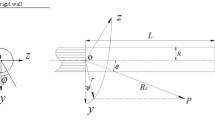Abstract
In order to predict acoustic radiation from a structure in waveguide, a method based on wave superposition is proposed, in which the free-space Green’s function is used to match the strength of equivalent sources. In addition, in order to neglect the effect of sound reflection from boundaries, necessary treatment is conducted, which makes the method more efficient. Moreover, this method is combined with the sound propagation algorithms to predict the sound radiated from a cylindrical shell in waveguide. Numerical simulations show the effect of how reflections can be neglected if the distance between the structure and the boundary exceeds the maximum linear dimension of the structure. It also shows that the reflection from the bottom of the waveguide can be approximated by plane wave conditionally. The proposed method is more robust and efficient in computation, which can be used to predict the acoustic radiation in waveguide.
Similar content being viewed by others
References
Bai MR, Chen CC (2011). On optimal retreat distance for the equivalent source method based near field acoustical holography. Journal of the Acoustical Society of America, 129(3), 1407–1416.
Bi CX, Chen XZ, Chen J (2008). Sound field separation technique based on equivalent source method and its application in near-field acoustic holography. Journal of the Acoustical Society of America, 123(3), 1472–1478.
Chen HY, Shang DJ, Li Q, Liu YW (2013). Sound radiation prediction for underwater structure by field-matching wave superposition method. Chinese Journal of Acoustic, 38(2), 137–146.
Favre CM, Hamzaoui N, Boisson C (2001). An approach for prediction of acoustic radiation from a structure with construction of the in situ vibroacoustic transfer function. Acta Acustica united with Acustica, 88, 93–103.
Gounot YJR, Musafir RE (2009). Genetic algorithms: a global search tool to find optimal equivalent source sets. Journal of Sound and Vibration, 322, 282–298.
Gounot YJR, Musafir RE (2011). Simulation of scattered field: Some guidelines for the equivalent source method. Journal of Sound and Vibration, 330, 3698–3709.
Herrin DW, Wu TW, Seybert AF (2004). The energy source simulation method. Journal of Sound and Vibration, 278, 135–153.
Jeans R, Mathews IC (1992). The wave superposition method as a robust technique for computing acoustic fields. Journal of the Acoustical Society of America, 92(2), 1156–1166.
Koopmann GH, Song LM, Fahnline JB (1989). A method for computing acoustic fields based on the principle of wave superposition. Journal of the Acoustical Society of America, 86(6), 2433–2438.
Machens KU (1999). Approximate solution for acoustic radiation problems: a critical appraisal of the method of comparative sources. Acustica, 85, 764–779.
Miller RD, Moyer JR, Huang H (1991). A comparison between the boundary element method and the wave superposition approach for the analysis of the scattered fields from rigid bodies and elastic shells. Journal of the Acoustical Society of America, 89(5), 2185–2196.
Min HQ, Chen WS, Qiu XJ (2011). Single frequency sound propagation in flat waveguides with locally reactive impedance boundaries. Journal of the Acoustical Society of America, 130(2), 772–782.
Pavic G (2006). A technique for the computation of sound radiation by vibrating bodies using multipole substitute sources. Acustica United with Acta Acustica, 92, 112–126.
Sarkissian A (1994). Method of superposition applied to scattering from a target in shallow water. Journal of the Acoustical Society of America, 95(5), 2340–2345.
Wang C, Bradley JS (2002). A mathematical model for a single screen barrier in open-plan offices. Applied Acoustics, 63, 849–866.
Wu TW (1994). On computational aspects of the boundary element method for acoustic radiation and scattering in a perfect waveguide. Journal of the Acoustical Society of America, 96(6), 3733–3743.
Yang Shie (2008). Theory of underwater sound propagation. Harbin Engineering University Press, Harbin, 18–26. (in Chinese)
Author information
Authors and Affiliations
Corresponding author
Additional information
Foundation item: Supported by the National Natural Science Foundation of China under Grant No. 11274080, and the Young Scientists Fund of the National Natural Science Foundation of China under Grant No. 11404313.
Hongyang Chen was born in 1984, Hubei, China. He is a doctor of the Science and Technology on Underwater Acoustic Laboratory at Harbin Engineering University, and works in the Key Laboratory of China Ship Development and Design Center. His research interests include acoustic radiation, structural vibration, wave propagation, scattering and acoustical holography.
Qi Li was born in 1958. He is head at the Underwater Acoustic Laboratory, Harbin Engineering University. He worked at the College of Underwater Acoustics, Harbin Engineering University from 1982 to 1993. He was a professor at Ocean University of China from 1993 to 2003. Then, he has been a professor at the College of Underwater Acoustics, Harbin Engineering University since 2003. He has presided national research projects including reverberation, scattering, wave propagation, sound measurement, structural acoustics, hydrodynamic noise, etc.
Dejiang Shang was born in 1969. He finished the postdoctoral research in the Academia Sinica in 2002. Since 2005, he has been a professor and PhD supervisor at Harbin Engineering University. He has received several awards and presided over twenty research projects, including the National Basic Research Program of China, the National High Technology Research and Development Program of China.
Rights and permissions
About this article
Cite this article
Chen, H., Li, Q. & Shang, D. Fast prediction of acoustic radiation from a hemi-capped cylindrical shell in waveguide. J. Marine. Sci. Appl. 13, 437–448 (2014). https://doi.org/10.1007/s11804-014-1270-x
Received:
Accepted:
Published:
Issue Date:
DOI: https://doi.org/10.1007/s11804-014-1270-x




